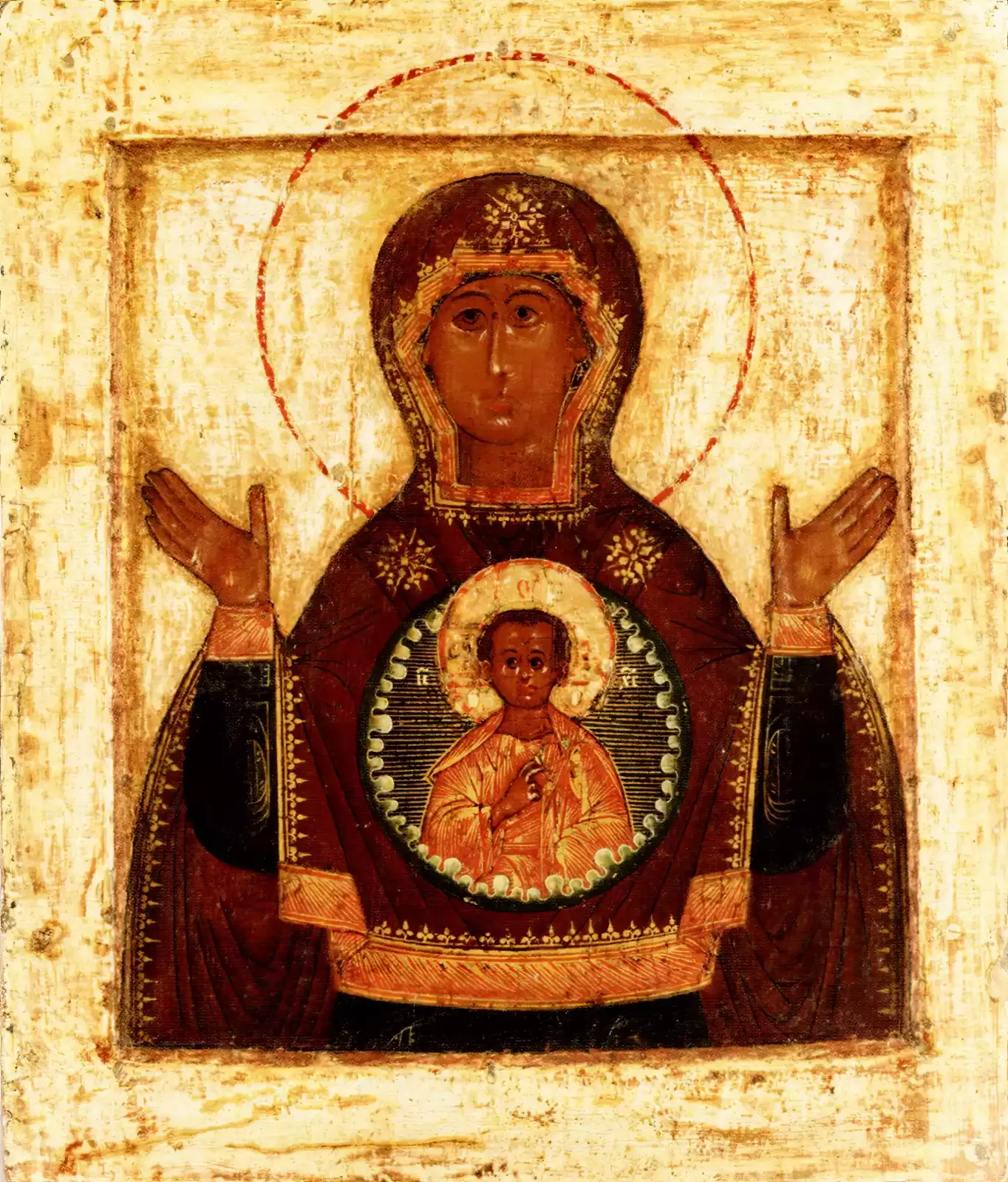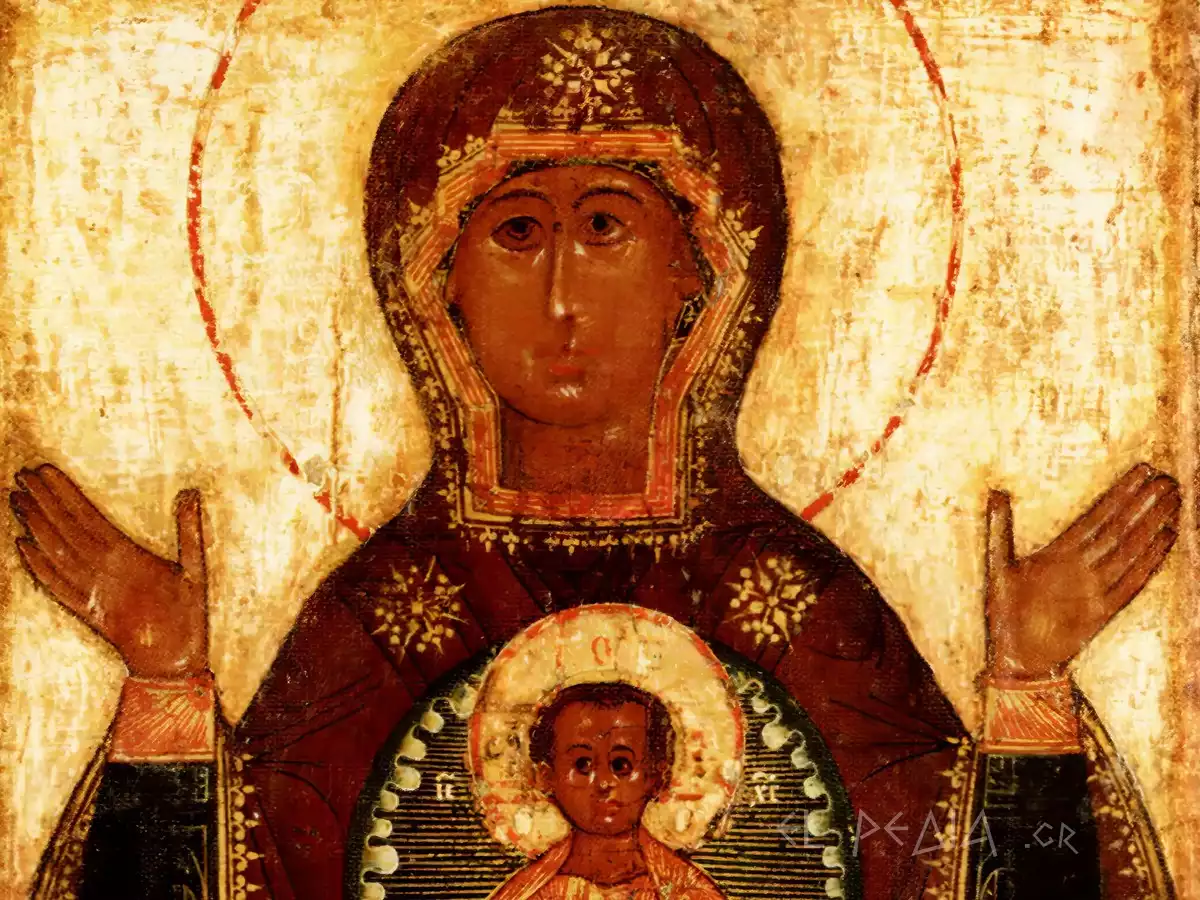
Title: Virgin of the Sign
Artist: Unknown Iconographer of the Novgorod School
Type: Portable Byzantine Style Icon
Date: circa 1600 AD
Dimensions: 53 x 41 cm
Materials: Egg tempera and gold leaf on wooden panel
Location: Museum of Russian Icons, Clinton, Massachusetts
The image of the Virgin of the Sign signifies the artistic and spiritual heights achieved by the Novgorod School around 1600 AD. This particular icon captures the Theotokos in a pose of profound supplication. This distinctive iconographic style, known as “Platytera” or “Virgin of the Sign,” draws its inspiration from the prophecy of Isaiah, which foretells the sign that the Lord himself will provide. This powerful imagery resonates deeply within the Orthodox tradition. The influence of Byzantine iconography, particularly its emphasis on spiritual expression, is undeniable, and echoes of this influence can be seen in the religious art of many countries.
The icon itself is executed with masterful skill. The lavish use of gold in the background creates an ethereal atmosphere, enhancing the sense of divine presence. The Virgin’s garments are rendered with stringent detail, their folds and textures adding all necessary depth and realism to the rendering. But what ensnares the viewer’s gaze is the Theotokos’ intense spirituality. Her look—a compassionate and serene one, as often described—invites contemplation. The strict technical virtuosity on display here, combined with the image’s heavy theological significance, makes this work one of the high points of this era in Russian iconography. Russian icons were, of course, for the religious veneration of their viewers. But they were also “windows” into the divine. They did what all good art can do: they drew their audiences into a spiritual realm. And what’s more, they accomplished this in a milieu of 17th-century Moscow that was seeing both artistic flourishing and religious fervor.
Stylistic Characteristics and Symbolism
The icon of the Virgin of the Sign is an excellent example of the artistic tradition of the Novgorod School. The technical execution is characterized by exceptional detail in the rendering of the figures and garments, using egg tempera and gold leaf on a wooden surface. The golden background, which dominates the composition, creates a sense of transcendence and spiritual brilliance, while simultaneously highlighting the central figures.
The depiction of the Theotokos in a posture of supplication, with hands raised in prayer, follows the traditional Byzantine style in rendering sacred figures, characterized by austerity and monumentality (Tarasov). At the center of the composition, within a circular medallion on the chest of the Virgin, is depicted Christ-Emmanuel, a symbolic reference to the incarnation of the Divine Word, which is a central doctrine of the Orthodox faith.
The color palette of the work is characterized by the dominance of deep tones of brown and burgundy in the garments of the Theotokos, which are rendered with exceptional attention to folds and details, creating a sense of volume and depth that contrasts with the flat golden surface of the background. This technique, characteristic of the Novgorod School, highlights the artist’s ability to combine traditional iconographic convention with a refined aesthetic perception.
The halos, intricately crafted with gold, surround the figures of the Virgin and Christ, emphasizing their sanctity and creating a visual hierarchy in the composition. The decorative treatment of the garments, with elaborate patterns and golden touches, reflects the luxury and technical perfection that characterized the iconographic production of the era, while also serving the symbolic character of the icon as a means of spiritual upliftment and prayer.
Historical and Theological Significance of the Virgin of the Sign
The tradition of the Virgin of the Sign was established in Novgorod during the 12th century, constituting a unique composition of Russian iconography that reflects the continuity of the Byzantine tradition in Russian art (Olsufiev). The Museum of Russian Icons in Clinton, Massachusetts, where the icon is currently housed, is an important center for the study of Russian iconographic art.
The artistic production of the Novgorod School during this period is characterized by a particular approach to rendering sacred figures, where the austerity of the Byzantine tradition is combined with elements of local artistic expression, creating a unique synthesis that deeply influenced the development of Russian iconography in subsequent centuries and shaped the distinctive character of Russian ecclesiastical art, while at the same time, the artists of the era, working with exceptional care and technical skill, managed to create works that combined spiritual gravity with artistic perfection.
The dimensions of the icon, 53 x 41 centimeters, make it ideal for personal devotion, while the choice of materials – egg tempera and gold leaf on a wooden surface – follows the traditional technique of iconography that had evolved through centuries of artistic practice and spiritual quest, as the craftsmen of the time paid particular attention to the selection and preparation of their materials, considering their work as a sacred ministry that required both technical perfection and spiritual preparation.
The dating of the icon around 1600 AD places it in a period of flourishing of Russian iconography, when artistic traditions had matured and techniques had been perfected through generations of iconographers who passed their knowledge from master to student, keeping the tradition alive and enriching it with new elements that reflected the spiritual and artistic quests of their time.

Analysis of Artistic Elements of Detail
This detail highlights the exceptional technical skill of the unknown iconographer of the Novgorod School. The face of the Theotokos, with large almond-shaped eyes and a delicate nose, follows the established typology of the Byzantine tradition. Her expression exudes serenity and spirituality.
The diadem adorning her head is intricately decorated with plant motifs, crafted with exceptional detail in gold. The rendering of the flesh tones is characterized by subtle gradations in brown tones, creating a sense of volume without violating the Byzantine anti-naturalistic tradition.
At the center of the composition, the circular medallion contains the figure of Christ-Emmanuel, framed by decorative elements reminiscent of pearls. The technical rendering of the infant Christ presents impressive maturity in the facial features, symbolizing his divine nature.
The golden background, with its subtle variations on its surface, creates a sense of timeless, transcendent space. The dark tones of the Theotokos’s garment serve as an excellent contrast, highlighting both her face and the central medallion with Christ.
The Virgin of the Sign as a Timeless Symbol
The Virgin of the Sign remains one of the most characteristic examples of Russian iconographic art, reflecting the rich tradition of the Novgorod School. The icon, dating around 1600, uniquely combines the Byzantine heritage with local artistic elements. The technical perfection in rendering the figures, the use of precious materials, and the careful treatment of details testify to the high level of artistic production of the era.
The significance of the icon extends beyond its artistic value. It is a testament to the cultural flourishing of Novgorod and the profound influence of Byzantine art on the formation of the Russian iconographic tradition. Its preservation at the Museum of Russian Icons in Clinton, Massachusetts, ensures the continuation of the study and appreciation of this important artistic legacy.
elpedia.gr
Bibliography
Kleimola, Ann M. “The Icon as Open Book: Reflections of North Russian Culture.” Russian History 33, no. 2/4 (2006): 199-221.
Olsufiev, Y. A. The Development of Russian Icon Painting from the Twelfth to the Nineteenth Century.” The Art Bulletin 12, no. 4 (1930): 347-373.
Tarasov, Oleg. Icon and Devotion: Sacred Spaces in Imperial Russia. London: Reaktion Books, 2004.

